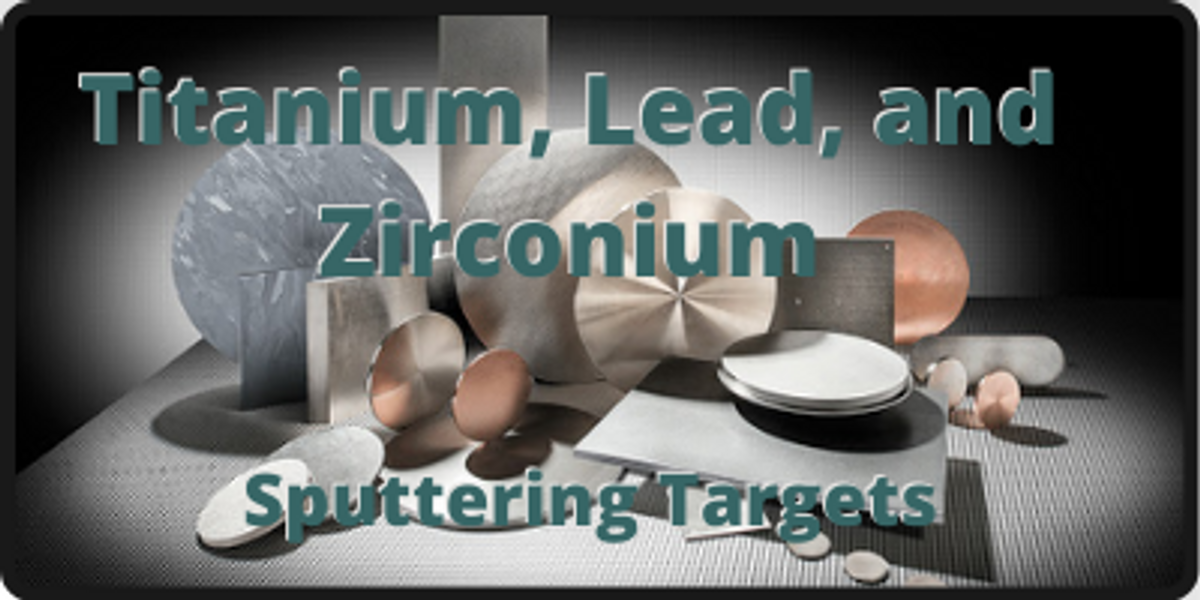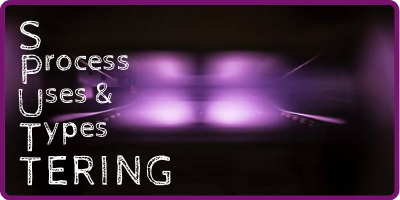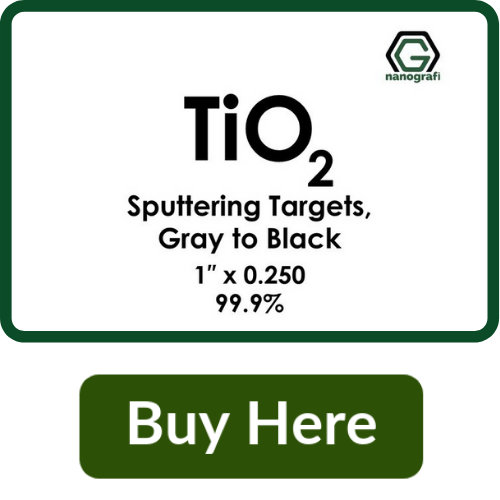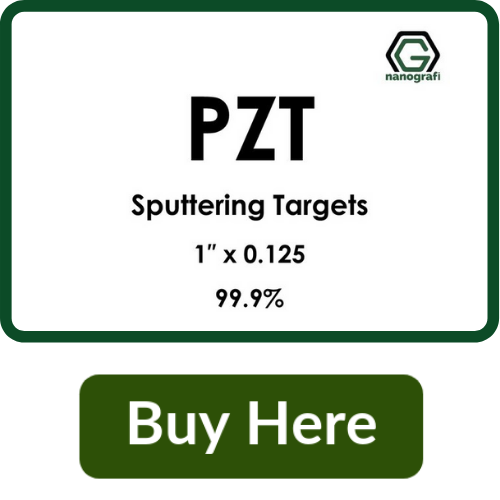Titanium, Lead, and Zirconium Sputtering Targets
The high
capacities in the field of lamination and metallization have in recent years
allowed the development of a new type of protective film. We are talking about
the latest generation of solar films, Sputtered series films, the result of
research and experimentation in the aerospace sector that are produced using
the process called "sputtering". It is a technological process based
on ionic pulverization able to overcome the problem of the low energy of the
atom. The disintegration of metals by ion bombardment allows the individual
atoms emitted by the affected material to be collected and incorporated into
the surface of the film, thus forming very thin selective coatings. In this
article, we will discuss all about the process of Sputtering Targets and
particularly about Titanium, Zirconium, and Lead Sputtering Targets.
Sputtering is used to deposit an atomic layer of different types of metals on the film, ensuring the production of denser films, with a better structure and adhesion, therefore more reliable and resistant. The uniformity of the coatings obtained by the coating is excellent and predictable because it acts uniformly. Sputtering is by far the most sophisticated and slower process, however, it has the power to produce many long-lasting films. Sputtered films respond effectively to precise and demanding requests, ensuring high light transmission and a remarkable reflection of solar energy. Sputtered target process guarantees excellent resistance even in very demanding environmental conditions such as corrosive vapors and humidity.
The scratch-resistant coating of such films is revolutionary, created from a complex composed of crossed and UV-resistant polymers, to obtain the longest lasting protective coating. This resistance is obtained by keeping the reflection and transparency unchanged and improves the overall performance of the films.
Modified Films
The process of Sputtering can also be modified to produce films without altering the chromatic gradations of the colors. Unlike normal films on the market, such films allow 99% of UV rays to be absorbed, thus guaranteeing the protection of furnishings and objects from discoloration due to them. By letting less than 1% of the UV rays filter through, they not only act as a protective screen to the internal objects but also allow a longer life for the film itself, which "protects itself".
Process of Sputtering
In this deposition technique, a target (anode) consisting of the material to be evaporated is bombarded with inert gas ions (Ar). Most of the energy-related to this process results in a heating of the target (increase in the thermal agitation of the atoms of the target), but in some cases, the energy transferred following the impact with a gas ion may result in the expulsion of the atom itself from the target. The material removed from the target can now be collected on support (substrate) placed in an appropriate position and distance from the target to form a thin film (film) of the target material.
It is a process that can be applied to any material, including those with very low vapor pressures. Given the "atomic" nature of the growth of the film on the substrate, this technique can produce even very small coating thicknesses. The experimental apparatus for deposition by sputtering is composed of a vacuum chamber equipped with a turbo molecular pump in series with a rotary pump, the pressures achievable with this system are in the order of 10-6 mbar.
Sputtering processes take place in a controlled atmosphere by a Residual Gas Analyzer. Also, the chamber is equipped with 2 sputtering sources: one in "dc" of 500W and the other in "RF"
Magnetron Sputtering
The magnetron sputtering process is very common for Titanium, Zirconium, and Lead. This process consists of the generation and confinement of a plasma of Argon gas (the positive ions of Argon) through an electric field, bombarding the surface of the source of the material to be deposited by extracting particles on a molecular and atomic scale, which are collected on the surface of the glass substrate.
The process then deposits thin layers, conductors or semiconductors on the glass panels and covers large curved surfaces, achieving absolute excellence in terms of electrical resistivity and light transmission. There are two plants for the application of the process, one of the reduced dimensions, the other much larger, to respond to the different configurations of the product.
Let’s now discuss Titanium, Zirconium, and Lead Sputtering Targets.
Before You Continue, Check This Article About Sputtering Targets Also
1.Titanium Sputtering Targets
Titanium Sputtering Target is widely used in the industry of multiple arc ion vacuum coating or Magnetron Sputtering PVD for decorative coating PVD or functional coating depends on the requirements.
The Titanium Sputtering Target has the advantage of high corrosion resistance, high strength and lightweight, which can be an ideal element used in the chemical industry, coated glass, etc. In order to reduce pores in the solids of the objective and improve the properties of the sprayed film, the objective is the characteristics of higher density.
Titanium Sputtering target plays an important role in the vacuum industry of multiple arc ions and Magnetron Sputtering PVD for decorative PVD coating or functional coating. In addition, there are several types of purity options, which are available according to different requirements. Made of high-quality titanium, the purity of the Titanium Sputtering target is more than 99%. The density of the lens not only affects the speed of spraying but also affects the electrical and optical properties of the film. There is no doubt that our product has a higher density, with better film performance. In addition, the high density and resistance of the lens account for the function to better resist thermal stresses during cathodic spraying. Due to the appropriate size and compact design, it is easier to store.
2.Zirconium Sputtering Targets
Zirconium for sputtering and coating of metal with the customer-specific size is known and is widely used in the field of PVD coating due to the high purity, the fine grain sizes, the homogeneous microstructure, the excellent surface quality, and the exact dimensions.
Zirconium Sputtering Target can be widely used in coating processing industries such as photonics, nanometer materials, optics, PDP, solar cells, touch panel industry, photovoltaic application, decoration, and other scientific research and industrial production areas. It consists of high-quality zirconium and is suitable for decorative coatings in brass-like colors, which are ideal for controls on devices and fittings. In addition, there are several types of sputter target options that offer more benefits for your needs. The purity of the zirconium sputtering target is more than 99%, which guarantees a longer service life. It is very easy to use and requires no special maintenance.
3.Lead Sputtering Targets
Lead Sputtering Targets are also of great importance due to the peculiar characteristics of Lead. Lead is a soft and malleable metal. It occurs in the earth's crust with a frequency of 14 ppm. Lead is mainly found in the "Galena" ore, lead (II) sulfide (PbS), which is often found in the form of gray, cubic crystals together with zinc blende, the sulfide of zinc. Lead reacts easily in moist air, is stable to oxygen and water, but dissolves in nitric acid. The thermal and electrical conductivity of lead is low, but it is relatively corrosion-resistant.
Lead is used in many areas; because of its relatively high impermeability to radiation, it is the ideal material for radiation protection devices used in radiology. In addition, lead is used in ceramic glazes, batteries, paints, as a fuel additive (tetraethyl lead) and as the main component of soft solder. Lead is a high-purity material that is used for sputtering. Lead Sputtering targets are used as the starting material for a wide variety of coating processes, such as PVD, laser or ion beam technology, etc.
Thus, the principle of sputtering technology is based on producing a luminescent discharge among 2 electrodes which is then taken in a rarefied atmosphere which creates plasma having charged photons, ions, electrons, and atoms. This electric field causes the positively charged particles to move and are attracted by the cathode. The process of Sputtering target uses different atoms such as Titanium, Lead, Zirconium, etc. These sputtering target elements offer a variety of advantages and have important applications. Sputtering is mainly used in the electronics and information industry, such as the integrated circuit, the liquid crystal display, the storage of information, the laser memory, the electronic control devices, etc.; It can also be applied to the field of glass coating; It can also be used in high-temperature-resistant materials, corrosion resistance, high-quality decoration products, and other industries.
References
https://iopscience.iop.org/article/10.1088/1742-65...
https://ceramics.onlinelibrary.wiley.com/doi/abs/1...
https://iopscience.iop.org/article/10.1088/1742-65...
https://www.sciencedirect.com/topics/materials-sci...
https://www.researchgate.net/publication/225621819...
https://www.sciencedirect.com/topics/materials-sci...
Recent Posts
-
What is the Difference Between 7075 and 6061 Aluminum Alloy?
When comparing 7075 aluminum alloy to 6061 aluminum alloy, it's essential to understand their disti …5th Apr 2024 -
Iron-Air Batteries: The Ultimate Guide
Iron-air batteries represent a significant breakthrough in energy storage technology, offering a sus …29th Mar 2024 -
Discovering the Power of 2D Materials
In material science, the discovery of two-dimensional (2D) materials represents a transformative de …22nd Mar 2024









